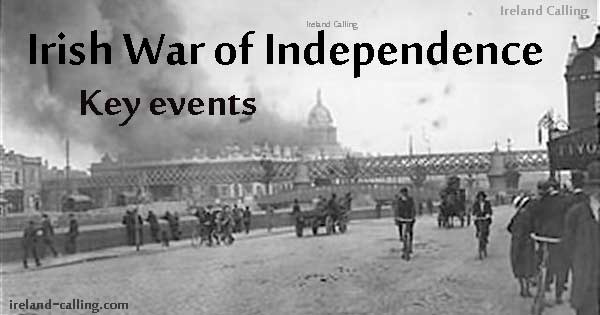The Irish War of Independence was a major event Ireland’s history. It played a major role in the country finally achieving its status as an independent republic.
Below are some short summaries about the key battles and events that took place during the War.
Declaration of Independence
Following their overwhelming support in Ireland in the 1918 General Election, Sínn Féin refused to take their seats in Westminster and instead set up the first Dáil in Mansion House, Dublin.
At their first meeting, 21st January 1919, they passed the Irish Declaration of Independence that stated Ireland was an independent republic. As the War of Independence broke out on the same day, the declaration was accepted by the majority of the Irish public.
Soloheadbeg Ambush
This was the first act of violence of the war. A group of the Tipperary division of the IRA, led by Séan Treacy, ambushed and killed two members of the Royal Irish Constabulary.
Dan Breen was one of the men involved and the authorities placed a £1,000 reward for anyone who had information that would lead to his arrest. Breen later admitted that the group wanted to start a war and knew that the only way to do so was to kill someone.
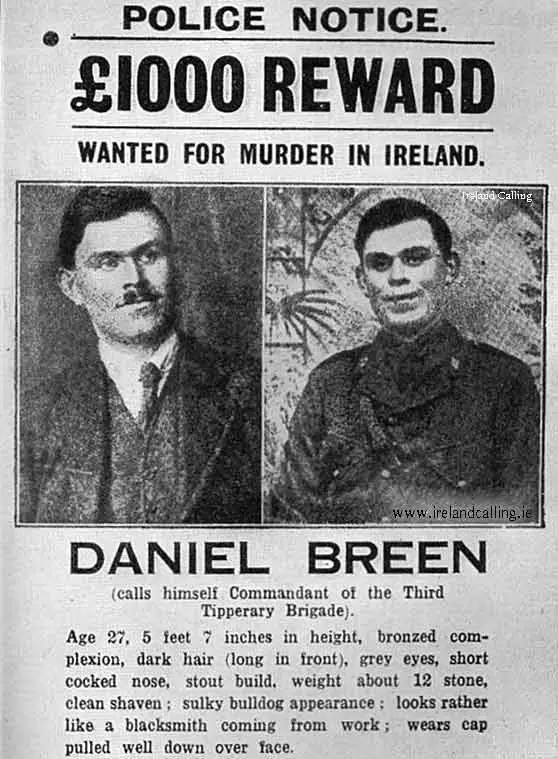
Rescue of Séan Hogan
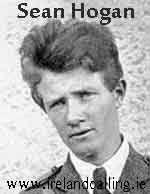 After the Soloheadbeg Ambush, the British authorities arrested Sean Hogan who had been one of the men involved in the attack.
After the Soloheadbeg Ambush, the British authorities arrested Sean Hogan who had been one of the men involved in the attack.
On the 13th May 1919 Hogan was being transferred to Cork by train. His IRA comrades who had also taken part in the ambush boarded the train at Knocklong and overpowered the armed guards that were holding Hogan.
Gunshots were fired and two policemen were killed, Treacy and Breen both suffered serious injuries.
The IRA did manage to rescue Hogan though, and removed his handcuffs with a well-aimed swing of a meat cleaver from the local butcher’s shop.
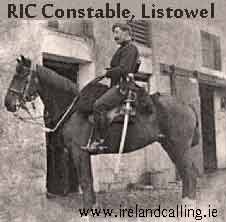
Listowel mutiny
In the summer of 1920, members of the RIC in Listowel refused to work after being ordered to ‘shoot on sight’ any suspected member of the IRA who failed to surrender. Many also refused to be relocated out of County Kerry to fight with the IRA in other parts of the country.
By this point, many RIC members in Listowel had become disillusioned with their superiors and their motives. Some had even left the force to fight alongside the IRA.
Rineen Ambush
On the 22nd September 1920, a troop of IRA soldiers, led by Ignatius O’Neill ambushed a lorry of RIC policemen in Rineen, County Clare. A local magistrate interrupted them as they were setting up the ambush and was shot twice in the head when he refused to surrender his car. The IRA dumped his body in a nearby lake.
They then ambushed the RIC lorry and killed six policemen. A further ten lorries were sent out by the RIC as Reinforcements, but the IRA managed to defend their position before making their escape with only two wounded.
That evening the RIC raided three local villages with the Black and Tans in frustration at the loss. They killed five civilians and burnt 16 houses and shops to the ground.
Death of Séan Treacy
Séan Treacy and Dan Breen had been wanted men since they killed two RIC policemen in the incident that started the war. They fled Tipperary and joined Michael Collins in Dublin, often working on important missions with the squad.
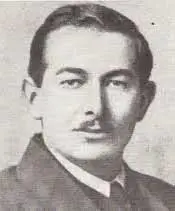
On 11 October 1920 the two were in a safe-house in Dublin when it was raided by armed police. They managed to escape but Breen suffered a serious injury and was taken to hospital under a false name by the IRA. Treacy was placed in the custody of the squad by Collins for his own protection.
However, he turned up late for a mission and didn’t realise that it had been aborted. Treacy was in a building surrounded by the British Army, who had been trailing him in the hope he would lead them to Collins.
As he left the building he was intercepted by armed police officers. Treacy refused to go down without a fight and drew his pistol. He managed to shoot two British officials, killing one, before he was shot in the head and killed instantly.
Tooreen Ambush
The West Cork Brigade of the IRA made their first real impact in the War of Independence in October 1920. Around 30 riflemen took up ambush positions on the road between Bandon and Cork lying in wait for the Essex division of the British Army.
The Essex had a reputation of brutality and torturing suspected IRA members for information. The IRA hated them and set up a mine on the road, knowing that the Essex travelled along it twice daily. .
However, when the first Essex lorry passed the mine didn’t set off, so the IRA threw a bomb but that also failed to detonate. The IRA riflemen opened fire on the lorry which sped off.
A second Essex lorry had by now arrived and those soldiers got out and returned fire. However, the IRA were well covered and suffered no injuries.
The Essex division surrendered. They had lost five men, and four more were seriously wounded. Six men were unharmed. The IRA let them return to their barracks. Members of the first Essex lorry were disciplined for desertion of the men in the second lorry.
Bloody Sunday
The most famous event of the War of Independence took place on 21st November 1920. The day began with several senior members of the IRA, including Michael Collins’ squad, setting out to numerous addresses in Dublin to assassinate members of the Cairo Gang. Of the 35 targets, eleven were killed, with the rest either escaping or not being at the suspected address in the first place. Two Black and Tans were also killed after getting involved in a gunfight.
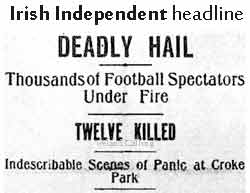 That afternoon, the RIC and Black and Tans opened fire on the crowds of spectators at a Gaelic football match at Croke Park. Fourteen civilians were killed either by gunshot, or from being trampled or crushed in the melee that ensued.
That afternoon, the RIC and Black and Tans opened fire on the crowds of spectators at a Gaelic football match at Croke Park. Fourteen civilians were killed either by gunshot, or from being trampled or crushed in the melee that ensued.
In the evening, three suspected IRA members that were being held at Dublin Castle were tortured and killed. The British Army claimed they had been killed after trying to escape. The IRA believed the men were moved from their cells to the guard’s room so that they could be tortured and killed, with the escape story made up as an excuse to kill them.
Kilmichael Ambush
The West Cork Brigade of the IRA ambushed two British Army vehicles in Kilmichael in Cork. They positioned themselves with rifles and grenades on either side of a road used by the British every day.
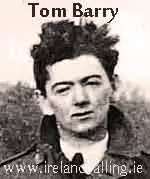
Tom Barry, the leader of the operation, stepped out into the road to force the first British lorry to slow down. The IRA opened fire and charged down from their concealed positions. A quick and brutal battle followed with all nine British soldiers being killed by rifles or bayonets.
A second vehicle arrived on the scene and the British soldiers got out and began shooting at the IRA. The British reportedly dropped their weapons in surrender and the IRA lowered their rifles.
The British soldiers then drew concealed pistols and killed three IRA volunteers. Barry then gave the order to his men to open fire once more and not stop until all the British soldiers were dead, which his troops duly did. Seventeen out of the eighteen British soldiers were killed.
Burning of Cork
On the 11th December 1920, the IRA ambushed a Black and Tan vehicle as it made a routine journey between checkpoints in the city. Several Black and Tans were wounded and one died from his injuries. The Black and Tans were furious with the attack and stormed into the nearest pub to try and identify the perpetrators.
They reportedly ordered everyone in the pub to lie with their faces on the ground, and dragged one young man out into the street, stripped him naked and ordered him to sing God Save the King.
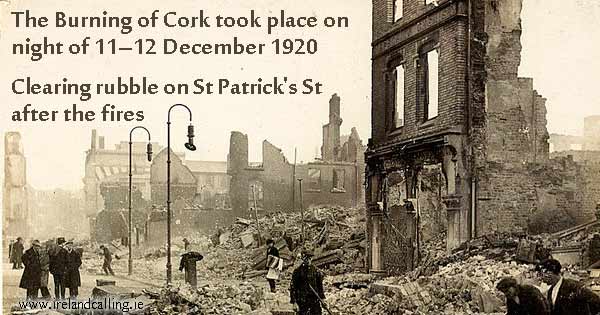
That evening, they stormed through the city of Cork on a trail of violence, abuse and destruction. Enraged by the earlier attack on them, and the loss of one of their men, the Black and Tans beat, robbed and abused anyone in Cork who offered up any resistance to them. They looted local businesses and set fire to homes and shops. When the fire brigade tried to put out the blazes they were forced to abandon their posts under a rain of bullets fired by the Black and Tans.
Two brothers were executed in their home in the early hours of the morning after being suspected of being involved in the earlier ambush.
The Burning of Cork is the most extreme case of the brutality and violence carried out by the Black and Tans in the War of Independence.
